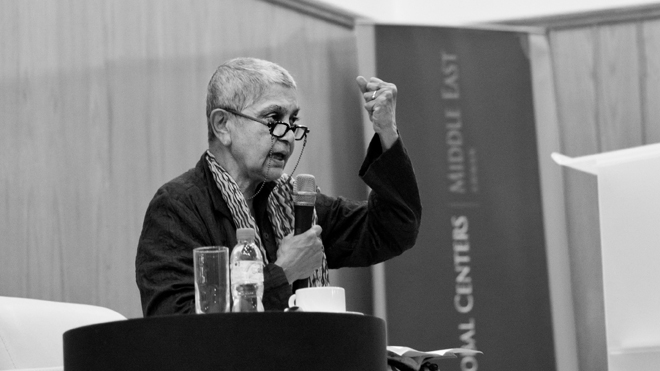By Siwar Masannat
“Humankind is not nice (in variable ways) to women and queers,” professor Gayatri Spivak had once said. “This ranges from killing them to passive aggressive behavior.” Nothing rings more true to my ears, especially in Jordan, where systematic and institutionalized discrimination against women and queers dominate our social, domestic, professional, and legislative spheres. Issues ranging from accepting sexuality and sexual behavior, to honor crimes, to the latest endowment of “civil but not political” rights to Jordanian women with foreign spouses are some general examples.
Spivak, who is a founding member of the Institute for Comparative Literature and Society, holds the title of University Professor at Columbia University, the only woman of color to hold the highest academic rank at the university in its 264-year history. She gave a talk in Amman last month at the Columbia University Middle East Research Center titled “How Can There Be a Feminist World?”
Spivak is a delightfully funny and engaging speaker. She describes her work within the humanities as “silent work”; one that sustains a long-term formation of problem solvers in lieu of momentary problem solving. Her idea for implementing change in the world is contingent on a “shift in desires”: a move from self-interest to interest in the “other”. She asserts that “heterosexual violence, homophobia, and rape are not exclusive “feminist” issues”. Spivak addresses bringing feminism to the world through different lenses: psychoanalytic, activist, and social/ethical.
In psychoanalytic terms, Spivak identifies a “sense of self” as understanding the self as a “bordered whole”. In the case of newborn babies who have still not developed consciousness, a sense of body is compounded with that of orifices in the body lends an understanding of self that is not only bordered, but also “permeable” to the outside world. In a transition from the notion of “borders” and “permeation”, Spivak describes gender as the “first instrument of abstraction”, one where sexual difference becomes perceivable and then “abstracted” within an arranged social (also socio-linguistic) understanding related to the cultural and social systems created by humankind. This speaks to the separation of gender and sex, where identification with gender as a social construct and identity does not necessarily have to align with a person’s biological sex. This also applies to the abstracted social, cultural values and traits attached to a particular gender.
Spivak balances her talk about gender between theoretical notions of semiotic attribution of gender (and therefore identity) to body and actual perceptions of a self’s body and the possible violence enacted on the bordered self. Perhaps her most memorable quote is that the “borderlessness is associated with pleasure in the long term”, and that work to change the world happens when the “imagination is trained to shift desires.” This notion of shifting of desire reiterated in Spivak’s lecture, and work in general, is supposed to entail a balance between attending to and respecting the borders of the permeable female body. Obviously, Spivak is speaking here of violence against women; she specifically points to the connection between violence and desire in terms of permeability. The nuanced understanding that she offers is key in demonstrating positive modes of self-acceptance in terms of sex drive and honoring of one’s safe sexual behavior practices, while simultaneously acknowledging sexual violence. This is a point that perhaps would have benefited from further discussion and elaboration, especially in the context of Jordanian (and Arab) restrictive views of the female body and female sexuality. Spivak also criticizes the international civil society’s activist and humanitarian practice of categorizing violence against women. She mentions how violence occurs in an “incalculable space” that should not be subject to a taxonomy of violence, where human suffering is “boxed” conveniently.
In discussing social theory, Spivak calls for changing the Hellenistic view of “Democracy” and moving towards an “intuition of democracy” that entails devising a philosophy of education. Democracy, according to Spivak, is not merely autonomy, nor is it for “self-selected moral entrepreneurs of civil society” who often help from above and do not actually engage with individuals affected by the cause at hand. Democracy should be based on the possibility of minorities: people not as same but as equal. Questions of rights concern both class and gender; an issue often overlooked in institutionalized “International Civil Society Feminism”, which sometimes carries undertones of unacknowledged racism (Spivak laughed about how “feudal benevolence” is better than “feudal malevolence”, but remains problematic nonetheless.) Spivak also mentions the problematic “internalized gendering” that happens within human rights efforts to support women’s issues, specifically when philanthropists do not see the people with whom they are working.
Spivak acutely criticizes the problematic notion of “raising awareness” regarding human rights issues, which she describes as unequal to education in its impact. An example of such campaigns might be the current Orange campaign drawing attention to “violence against women”: an embarrassingly futile, superficial bandage on the cleft that is violent inherent discrimination against women in our collective Jordanian psyche. Violence against women is an issue that is the result of a legacy of a systematic (though culturally specific and definitely contextually complex) view of women as lesser than men in humankind’s social and moral understanding. In a case such as Jordan, sexism is further sanctioned by so-called traditions that will not be shaken by an orange outfit (never mind that Orange Telecom is a supporter for the campaign). Sexism in Jordan is compounded by the legacy of colonialism, and current political milieu allowing interfering hands to “mold” a Jordanian identity. This is an issue that is also legally sanctioned by a broken and sexist legislative body of work that does not even begin to recognize women as equal to men in the constitution.
However, as much as I do share Spivak’s reluctance to indiscriminately embrace raising the public’s awareness regarding feminist issues, I do believe that this is a process that is still important. Perhaps what we need is to reenvision what “raising public awareness” is. Perhaps what Spivak characterizes as “education” should extend to public awareness and all other areas of society’s interactions with individuals and groups. If campaigns for raising awareness are rhetorically constructed with attention to the depth and nuances of the issue at hand, sensitivity to the diversity of society’s identities, and an accessible logic adhering to ethics of representation, I do not see why it would be ineffective.
Characterizing herself as a “personal trainer for the rearrangement of desire” and an agent of “training the imagination in epistemological performance”, Spivak explains how focus on education should not be on money, but rather on time and skill. Particularly fascinating is how she elucidates difference in quality and quantity of education in regards to human rights and feminist activism. This particularly rings true when considering Jordan’s boasting of “decreased illiteracy rates” that has not been accompanied by necessary reforms in the educational system and curricular design. Add to this the obvious gap in the quality of education across social classes and governorates. Naturally, by no means am I implying a generalized classist view of the underprivileged as less educated. However, it is certainly glaringly obvious that in dealing with financially marginalized, isolated, or dispossessed groups, quality ceases to be a priority of most (if not all) agents responsible for providing education. What Spivak focuses on is how, generally, human rights organizations focus on “quantity” and completely disregard the need for a real engagement that may address issues of reenvisioning the “other” and one’s own identity.
Spivak also discusses specific contexts where women feel (and are) socially obliged to care for others, and how to their exploitation in the workplace as they do not regard themselves outside of the paradigm of the service as an inherently womanly duty. In cases like this, Spivak argues, “training of the imagination for epistemological performance” is challenging in the sense that a woman would have to work within a contradictory realm of reenvisioning its own selfhood as well as other selfhoods. She likens this process to the Marxist call for the proletariat to envision themselves as “agents of production” rather than “victims of capitalism.”
Some of the audience’s questions to Spivak may illustrate the problematic rhetoric and lack of critical skills applied to general discussion in this community. It is safe to say that most questions exemplified a specific “lack of imagination” in the discourse surrounding women’s issues and feminism in Jordan. Questions regarding how/why she did not address education, “males”, the fact that she was not a mother, and an amusingly absolutist understanding of “self-interest” as opposed to “interest in the other”, dominates the Q&A session following the lecture.
For an Arabic translation of this article, click here.







